-
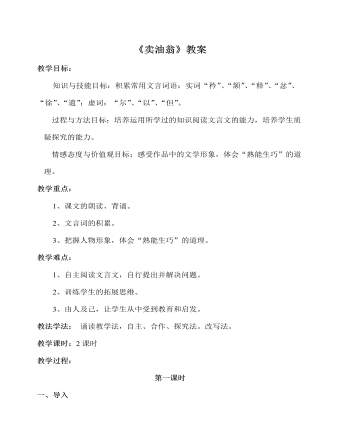
部编版语文七年级下册《卖油翁》教案
教学目标:知识与技能目标:积累常用文言词语:实词“矜”、“颔”、“释”、“忿”、“徐”、“遣”;虚词:“尔”、“以”、“但”。过程与方法目标:培养运用所学过的知识阅读文言文的能力,培养学生质疑探究的能力。情感态度与价值观目标:感受作品中的文学形象,体会“熟能生巧”的道理。教学重点:1、课文的朗读、背诵。2、文言词的积累。3、把握人物形象,体会“熟能生巧”的道理。教学难点:1、自主阅读文言文,自行提出并解决问题。2、训练学生的拓展思维。3、由人及己,让学生从中受到教育和启发。教法学法: 诵读教学法,自主、合作、探究法。改写法。教学课时:2课时

部编版语文七年级下册《老王》教案
阅读8-22自然段(第三部分)有一天,我在家听到打门,开门看见老王直僵僵地镶嵌在门框里。 “镶嵌”一词用得合适吗?为什么?合适。运用夸张的手法,强调了老王步履维艰,身体僵直的形态。指出这一段的外貌描写他面如死灰,两只眼上都结着一层翳,分不清哪一只瞎,哪一只不瞎。说得可笑些,他简直像棺材里倒出来的,就像我想像里的僵尸,骷髅上绷着一层枯黄的干皮,打上一棍就会散成一堆白骨。给加红色的字注音翳 yì眼角膜病变后留下的疤痕 骷髅 kūlóu注音释义往常他坐在蹬三轮的座上,或抱着冰伛着身子进我家来,不显得那么高。伛yǔ:弯(腰)曲(背)这几句外貌描写起什么作用?表现老王病重,烘托他的忠厚善良以及和对我家的深厚情意。比较下边每组两个句子,联系上下文,说说①在表达上的好处。
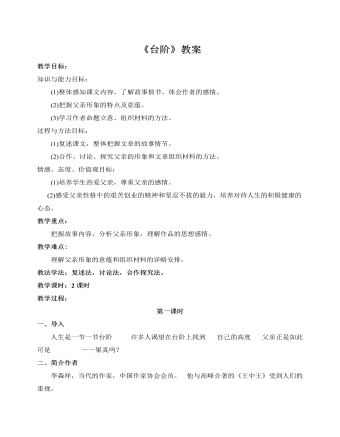
部编版语文七年级下册《台阶》教案
父亲是一个非常要强的农民,有志气,不甘人后,有长远的生活目标,有愚公移山的精神和坚韧不拔的毅力。老实厚道,诚实,不怕千辛万苦,有着中国传统农民所特有的谦卑。 作者写作本文的目的是什么?小说塑造了发展中的中国农村一个农民的典型形象。他的血管里有我们民族拼命硬干、坚忍不拔的精神,他身上所具备的优秀品质代表了新旧交替时期中国农民的突出特征。同时,这一形象还告诉我们,农民创业之所以如此艰难困苦,根源在于经济落后。亿万农民的希望在于先进的生产力,以此迅速改变农村落后面貌,结束老牛拉破车的日子。作者对父亲的优秀品质表示敬仰和赞叹;对父亲身上的中国传统农民所特有的谦卑表示同情;对改变农村的面貌寄予希望。 六、 语言理解1、 “父亲坐在绿阴里,能看见别人家高高的台阶,哪里栽着几棵柳树,柳树老是摇来晃去,却摇不散父亲那专注的目光。这时,一片片旱烟的烟雾在父亲头上飘来飘去。”这一处描写表现了父亲什么样的思想感情?为什么不用心理描写?
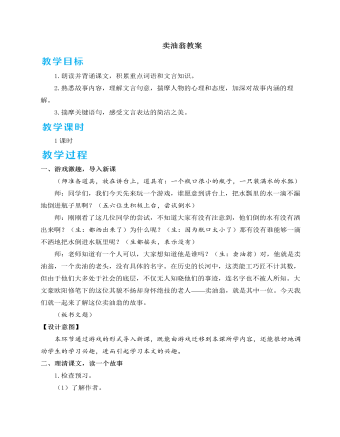
人教部编版七年级下册卖油翁教案
本篇故事虽短,但记述简洁生动,情趣盎然,人物形象鲜明,哲理深入浅出,是学生了解传统文化,学习浅易文言文,增强文言语感的经典文言小品文。所以本教学设计首先注重落实字词基础;然后用抢答的方式帮助学生理解课文内容;再以人物为核心,细读课文,通过表演的方式,抓住重点实词、虚词,揣摩人物的心理和个性特点,了解文言语言简洁精练的特点,激发学生学习文言文的兴趣。通过质疑探究,走进文本背后,引导学生学习探究文言故事的方法,培养学生独立思考、质疑探究的能力。文学知识笔记体小说笔记体小说指具有小说性质,介于随笔和小说之间的一种文体,是中国古典小说的一种。笔记体小说多以人物趣闻逸事、民间故事传说为题材,具有写人粗疏、叙事简约、篇幅短小,形式灵活、不拘一格的特点。笔记体小说的起源可以追溯到南朝刘义庆的《世说新语》。代表作有清代纪昀的《阅微草堂笔记》等。
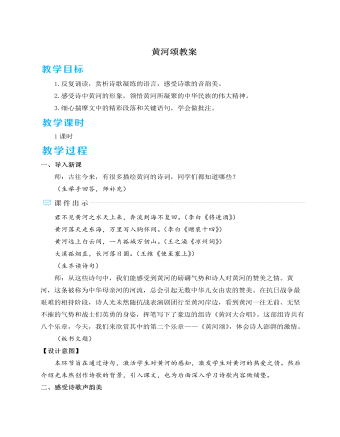
人教部编版七年级下册黄河颂教案
资料链接1.《黄河大合唱》《黄河大合唱》是由光未然作词、冼星海谱曲的一部大型合唱音乐作品,有《黄河船夫曲》《黄河颂》《黄河之水天上来》《黄水谣》《河边对口曲》《黄河怨》《保卫黄河》《怒吼吧,黄河!》八个乐章。诗中将雄奇的想象与现实的图景结合在一起,组成了一幅幅壮阔的历史画卷。2.中华民族精神中华民族在悠久的发展历史中,积淀和形成了自己独特而伟大的民族性格和民族精神。中华文化的基本精神,表现了自强不息、居安思危、厚德载物、乐天知足、崇尚礼仪等特征。中华文化的力量,集中体现为民族精神的力量。中华民族精神的核心是爱国主义。这种精神就像是泰山、长城一般壮丽地雄峙于世界的东方!疑难探究如何把握《黄河颂》语言上的特点?这首歌词写得明快雄健,节奏鲜明,音节洪亮。以短句为主,兼以长句;长短结合,自由奔放并且错落整齐。在韵脚上,隔二三句押韵,形成了自然和谐的韵律。

人教部编版七年级下册老山界教案
【设计意图】本环节既总结了学习的内容,也拓展了文章的主题;引导学生理解长征精神在当今时代的作用、意义,并传承长征精神,接受革命传统教育。四、总结存储1.教师总结。文章在叙述红军翻越老山界的经过中,进行了富有抒情气息的描写,展现了红军伟大的精神力量,也让我们感受到了长征岁月中浪漫的英雄情怀。岁月沧桑,斗转星移,中国已发生翻天覆地的变化,长征精神亦成为中华民族的宝贵精神财富。年轻一代的我们,应坚定信念,弘扬长征精神,为中华民族的伟大复兴而努力,弹奏新征途的“天籁之音”。2.布置作业。(1)课外选读:《大渡河畔英雄多》(杨得志)、《越过夹金山,意外会亲人》(杨成武)。(2)以小组为单位编写一期有关长征精神的手抄报,参加班级展示活动。
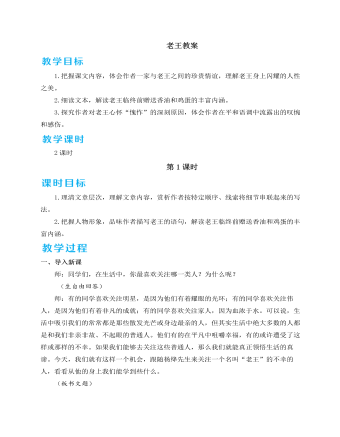
人教部编版七年级下册老王教案
素养提升作文中怎样运用“以小见大”的写作手法(1)以小人物见大。这里的“小人物”是指在社会上不出名、没有影响的人。以小人物见大,即以生活中平凡的小人物为叙写对象,通过塑造小人物的形象,揭示其闪光的品质,彰显其伟大的人格,折射出底层人民的光芒,喻人以大道理,动人以大感情,从而起到激励、感化读者的大作用。(2)以小事见大。可以通过叙写生活中极其平常的小事阐述一个大的道理。文化常识典故故事——君子之交“君子之交”语出《庄子·山木》:“且君子之交淡若水,小人之交甘若醴;君子淡以亲,小人甘以绝。”君子之交,意思是贤者之间的交情,平淡如水,不尚虚华。唐贞观年间,薛仁贵尚未得志之前,与妻子住在一个破窑洞中,衣食无着落,全靠王茂生夫妇接济。后来,薛仁贵参军,在跟随唐太宗李世民御驾东征时,立下汗马功劳,被封为“平阳郡公”。一登龙门,身价百倍,前来送礼祝贺的文武大臣络绎不绝,可都被薛仁贵婉言谢绝了。
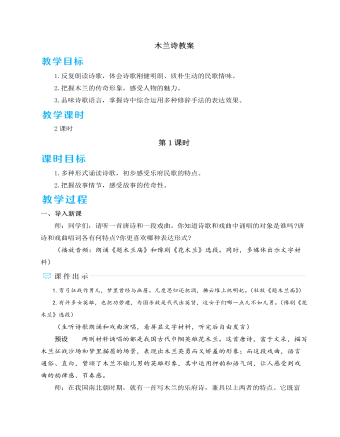
人教部编版七年级下册木兰诗教案
本教学设计着眼于民歌特点。第1课时重在诵读诗歌,设计不同层次的读,引导学生从诗歌的形式、节奏、韵律、情感四个方面感受民歌形式自由、具有韵律美、节奏感强、情感富于变化的特点,从而体会民歌的情味。第2课时重在品读诗歌,引导学生通过品析情节、品味语言、析读主题等方式,体会诗歌语言刚健明朗而质朴生动的特点,逐层解读民歌所塑造的传奇形象,并理解民歌所传达的爱国情怀。素养提升互 文互文,也叫互辞,是古诗文中常用的一种修辞手法。古文中对它的解释是:“参互成文,合而见义。”具体地说,它是这样一种表现形式:上下两句或一句话中的两个部分,看似各说两件事,实则是互相呼应,互相阐发,互相补充,说的是一件事。即上下文义互相交错、互相渗透、互相补充地来表达一个完整的意思。初中阶段,常见的互文一般有三类:(1)单句互文单句互文,即在同一个句子中前后两个词语在意义上相互交错、渗透、补充。如:秦时明月汉时关。
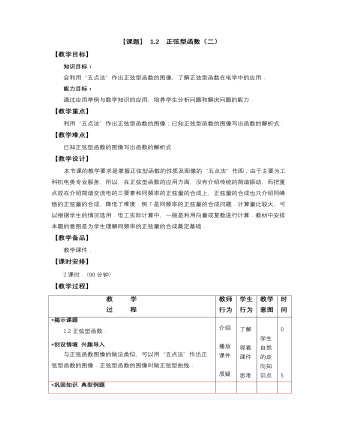
【高教版】中职数学拓展模块:1.2《正弦型函数》教学设计
教 学 过 程教师 行为学生 行为教学 意图时间 *揭示课题 1.2正弦型函数. *创设情境 兴趣导入 与正弦函数图像的做法类似,可以用“五点法”作出正弦型函数的图像.正弦型函数的图像叫做正弦型曲线. 介绍 播放 课件 质疑 了解 观看 课件 思考 学生自然的走向知识点 0 5*巩固知识 典型例题 例3 作出函数在一个周期内的简图. 分析 函数与函数的周期都是,最大值都是2,最小值都是-2. 解 为求出图像上五个关键点的横坐标,分别令,,,,,求出对应的值与函数的值,列表1-1如下: 表 001000200 以表中每组的值为坐标,描出对应五个关键点(,0)、(,2)、(,0)、(,?2)、(,0).用光滑的曲线联结各点,得到函数在一个周期内的图像(如图). 图 引领 讲解 说明 引领 观察 思考 主动 求解 观察 通过 例题 进一 步领 会 注意 观察 学生 是否 理解 知识 点 15
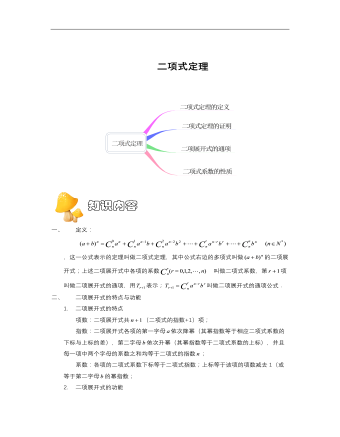
【高教版】中职数学拓展模块:3.2《二项式定理》教学设计
一、定义: ,这一公式表示的定理叫做二项式定理,其中公式右边的多项式叫做的二项展开式;上述二项展开式中各项的系数 叫做二项式系数,第项叫做二项展开式的通项,用表示;叫做二项展开式的通项公式.二、二项展开式的特点与功能1. 二项展开式的特点项数:二项展开式共(二项式的指数+1)项;指数:二项展开式各项的第一字母依次降幂(其幂指数等于相应二项式系数的下标与上标的差),第二字母依次升幂(其幂指数等于二项式系数的上标),并且每一项中两个字母的系数之和均等于二项式的指数;系数:各项的二项式系数下标等于二项式指数;上标等于该项的项数减去1(或等于第二字母的幂指数;2. 二项展开式的功能注意到二项展开式的各项均含有不同的组合数,若赋予a,b不同的取值,则二项式展开式演变成一个组合恒等式.因此,揭示二项式定理的恒等式为组合恒等式的“母函数”,它是解决组合多项式问题的原始依据.又注意到在的二项展开式中,若将各项中组合数以外的因子视为这一组合数的系数,则易见展开式中各组合数的系数依次成等比数列.因此,解决组合数的系数依次成等比数列的求值或证明问题,二项式公式也是不可或缺的理论依据.
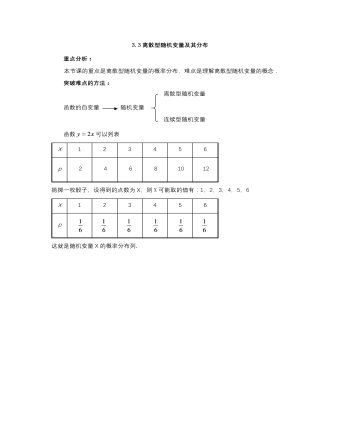
【高教版】中职数学拓展模块:3.3《离散型随机变量及其分布》教学设计
重点分析:本节课的重点是离散型随机变量的概率分布,难点是理解离散型随机变量的概念. 离散型随机变量 突破难点的方法: 函数的自变量 随机变量 连续型随机变量 函数可以列表 X123456p 2 4 6 8 10 12

新人教版高中英语必修3Unit 1 Festivals and celebrations-Discovering Useful Structure教学设计
4.That was an experience that frightened everyone. →That was _____________________. 答案:1. taking 2. being discussed 3. in the reading room 4. a frightening experienceStep 6 The meaning and function of V-ing as the predicative动词-ing形式作表语,它通常位于系动词后面,用以说明主语“是什么”或“怎么样”一种表示主语的特质、特征和状态, 其作用相当于形容词; 另一种具体说明主语的内容, 即主语等同于表语, 两者可互换。The music they are playing sounds so exciting. 他们演奏的音乐听起来令人激动。The result is disappointing. 结果令人失望。Our job is playing all kinds of music. 我们的工作就是演奏各种音乐。Seeing is believing. 眼见为实。Step 7 Practice1. It is ________(amaze) that the boy is able to solve the problem so quickly.2. Buying a car is simply _______(waste) money. 3. Please stop making the noise—it’s getting ________(annoy). 4. complete the passage with the appropriate -ing form.La Tomatina is a festival that takes place in the Spanish town Bunol every August. I think many food festivals are __________ because people are just eating. however, this festival is _________ because people don't actually eat the tomatoes. Instead, they throw them at each other! the number of people ________ part in this tomato fight, can reach up to 20,000, and it is a very __________ fight that lasts for a whole hour. The _______ thing is how clean Bunol is after the tomatoes are washed away after the fight. this is because the juice form tomatoes is really good for making surfaces clean!答案:1. amazing 2. wasting 3. annoying4. boring interesting taking exciting amazing

新人教版高中英语必修3Unit 1 Festivals and Celebrations-Reading and Thinking教学设计
The topic of this part is “Discover the reasons for festivals and celebrations.The Listening & Speaking & Talking part aims at talking about the experiences and feelings or emotions about the festivals and celebrations. This section aims at detecting the reason why the people celebrate the festivals, the time, the places, the types and the way of celebrations. It also explains why some traditions in the old celebrations are disappearing, like the firecrackers in the big cities and some new things are appearing like the prosperity of business or commerce. 1. Students can talk about what festivals they know and the reasons and the way of celebrating them.2. Students should learn the reading skills such as the headline and get the topic sentences, the structures of articles.3. Students can understand the past, the present situation of some festival around the world and why there are some changes about them. 4. Students can have the international awareness about the festivals.1. Students should learn the reading skills such as the headline and get the topic sentences, the structures of articles.2. Students can understand the past, the present situation of some festival around the world and why there are some changes about them.Step 1 Lead in---Small talkWhat festival do you like best ? Why ?I like the Spring Festivals because I can set off the fireworks, receive the lucky money and enjoy the Gala with my families.Step 2 Before reading---Pair workWhy do people celebrate different festivals ?The Spring Festivals is to celebrate the end of winter and the coming of spring and new life.The Mid-autumn Day is to celebrate the harvest and admire the moon.

新人教版高中英语必修3Unit 1 Festivals and Celebrations-Listening &Speaking&Talking教学设计
The theme of this section is “Talk about festival activities and festival experiences”.Festival and holiday is a relaxing and interesting topic for students. This part talks about the topic from the daily life of students’. In the part A ---Listening and Speaking, there are three conversations among different speakers from three countries(Japan, Rio and China), where the speakers are participating in or going to participate in the festivals and celebrations. So listening for the relationship among them is a fundamental task. Actually, with the globalization and more international communication, it is normal for Chinese or foreigners to witness different festivals and celebrations in or out of China. In the Conversation 1, a foreign reporter is interviewing a Japanese young girl who just had participated in the ceremony of the Coming-of-Age Day on the street and asking her feeling about the ceremony and the afterwards activities. Conversation 2, Chinese girl Li Mei is witnessing the Rio Carnival for the first time, and her friend Carla gives her some advice on the costumes which enables her to match with the carnival to have a good time. Conversation 3, a Chinese guide is showing a group of foreign visitors around the Lantern Festival and introducing the customs of the festival to them. The three conversations have a strong vitality and insert the festival and cultural elements from different countries. So perceiving the festivals and cultures from different countries is the second task. At the same time, the scripts also insert the targeted grammar --- v-ing as attributive and predicative, which students can perceive and experience in a real context and make a road for the further study. That is the third task. In the Part B--- Listening and Talking, the theme is “Talk about festival experience”, which is the common topic in our daily conversations. During the conversation, Song Lin, a Chinese student, asked Canadian friend Max about how to spend Christmas. In the conversation, Song Lin talked about experience and the feelings during the Chinese Spring Festival, during which there are not only some enjoyable things but some unpleasant things. After the listening, perhaps students find there are some similarities between Christmas and the Chinese Spring Festival as there are some differences in the origins and celebrations. For example, people always visit friends and relatives, decorate their houses, have a big dinner together, chat and give presents to each other.

新人教版高中英语必修3Unit 1 Festivals and Celebrations-Reading for writing教学设计二
Step 3 Analyzing article structureActivity 31. Teachers raise questions to guide students to analyze the chapter structure of this diary and think about how to describe the festival experience. (1)What should be included in the opening/body/closing paragraph(s)?(2)How did the writer arrange his/her ideas?(3)What kind of interesting details did the writer describe?(4)How did the writer describe his/her feelings/emotions during the event?2. Students read and compare the three sentence patterns in activity 2. Try to rewrite the first paragraph of the diary with these three sentence patterns. After that, students exchange corrections with their partners. Such as:●This was my first time spending three days experiencing the Naadam Festival in China’s Inner Mongolia Autonomous Region and it was an enjoyable and exciting experience. ●I'll never forget my experience at the Naadam Festival because it was my first time to watch the exciting Mongolian games of horse racing, wrestling, and archery so closely. ●I'll always remember my first experience at the Naadam Festival in China’s Inner Mongolia Autonomous Region because it was so amazing to spend three days witnessing a grand Mongolian ceremony. Step 4 Accumulation of statementsActivity 41. Ask the students to read the diary again. Look for sentences that express feelings and emotions, especially those with the -ing form and the past participle. Such as:● …horse racing, wrestling, and archery, which are all so exciting to watch. ● some amazing performances● I was surprised to see…● I was a little worried about. . . ● feeling really tiredOther emotional statements:●I absolutely enjoyed the archery, too, but the horse races were my favourite part. ●I'm finally back home now, feeling really tired, but celebrating Naadam with my friend was totally worth it. ●He invited me back for the winter to stay in a traditional Mongolian tent and cat hot pot. I can’t wait!2. In addition to the use of the -ing form and the past participle, the teacher should guide the students in the appreciation of these statements, ask them to memorize them, and encourage them to use them reasonably in writing practice.

新人教版高中英语必修3Unit 1 Festivals and Celebrations-Reading for Writing教学设计一
The topic of this part is “Write about your festival experience”.During the Listening and Speaking and Talking, students are just asked to say out their festival experiences such as the Spring Festival, Mid-autumn Day, but this part students will be asked to write down their own festival experiences. During the reading part, it introduces the Naadam Festival in Inner Mongolia Autonomous Region, which can give students a good example to imitate. Students not only learn the festival, but touch and feel the Inner Mongolian’s character, the spirit and cultural atmosphere, which can help students form the cultural awareness and learn to enjoy and value the diversity of Chinese culture.Concretely, the dairy tells the experience that the author spent the Naadam Festival in Inner Mongolia Autonomous Region with his/her friend. The structure is clear. In the opening paragraph, it introduces the topic of the Naadam Festival and the whole feeling. Then it introduces the items of the festival like the ceremony, wrestling and horse racing. Finally, it summarizes this experience. Because this part is a travel journal, we must guide students pay more attention to these details: 1. use the first person. 2. use the past tense to tell the past thing and use the present or future tense to describe the scenery. 3. use the timeline to tell the development. 4. be careful for the author’s psychology, emotion and feeling, etc.1. Read quickly to get main idea; read carefully to get the detailed information about Naadam Festival.2. Learn the structure of the reading article and language.3. Write an article about a festival experience4. Learn to use the psychology, emotions and feeling in the writing.1. Write an article about a festival experience.2. Use the structure of the reading article and language.

新人教版高中英语必修3Unit 2 Morals and Virtues-Discovering Useful Structure教学设计
1. 表示时间。Hearing these stories, I’m skeptical about the place. = When I heard these stories. . . 2. 表示原因。Not knowing his address, I can’t send this book to him. = Because/Since/As I don’t know his address. . . 3. 表示结果。His father died, leaving him a lot of money. =. . . and left him a lot of money4. 表示条件。Going straight down the road, you will find the department store. = If you go straight down the road. . . 5. 表示让步。Being tired, they went on working. =Although they were tired. . . 6. 表示行为方式、伴随情况或补充说明。He lay on the grass, staring at the sky for a long time. =. . . and stared at the sky for a long time注意:非谓语动词作状语时, 如所提供的动词不能和句子中的主语保持一致, 动词-ing形式必须有自己的逻辑主语, 通常由名词或代词来担任, 这就是独立主格结构。The last bus having gone, we had to walk home. (having gone的逻辑主语是the last bus, 而不是we)Weather permitting, the football match will be played on Friday. (permitting的逻辑主语是time, 而不是the football match)Step 7 Practice1. ________(study) hard, you are sure to get first prize. 2. People use plastic in their daily life, _______(leave) large amounts of waste. 3. ________(work) hard at your lessons, you are to succeed. 4. The old man, ____________(work) abroad for twenty years, is on the way back to his motherland. 5. ______________(finish) his homework, he was playing on the playground. Answers: 1. Studying 2. leaving 3. Working 4.having worked 5. Having finishedStep 8 HomeworkFinish the homework on Page 22.
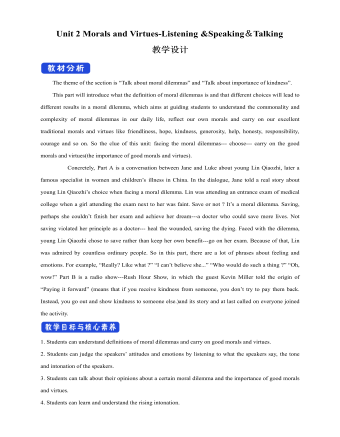
新人教版高中英语必修3Unit 2 Morals and Virtues-Listening &Speaking&Talking教学设计
Example:One day, a poor boy who was trying to pay his way through school by sending newspapers door to door found that he only had one dime(一角)left. He was so hungry that he decided to beg for a meal at the next house.However, he lost his nerve when a lovely young woman opened the door. Instead of a meal he asked for a drink of water. She thought he looked hungry so she brought him a large glass of milk. He drank it slowly, and then asked, “How much do I owe you?” “You don’t owe me anything,” she replied, “Mother has taught me never to accept pay for a kindness.” “Then I thank you from the bottom of my heart.” With these words, Howard Kelly left that house.Years later the woman became badly ill and was finally sent to the hospital in a big city. Dr. Howard Kelly, now famous, was called in. When he heard the name of the town she came from, a strange light filled his eyes. Dressed in his doctor’s clothes, Dr. Kelly went into her room and recognized her at once. From that day on, he gave special attention to her, and decided to do his best to save her life.At last the woman was saved. Dr. Kelly asked the business office to pass the final bill to him. He looked at it and then wrote something on the side. The bill was sent to the woman’s room. She was afraid to open it because she was sure that it would take the rest of her life to pay for it off. Finally she looked, and the note on the side of the bill caught her attention. She read these words: “Paid in full with a glass of milk, Dr. Howard Kelly.” Tear of joy flooded her eyes.

新人教版高中英语必修3Unit 2 Morals and Virtues-Reading and Thinking教学设计
The topic of this part is “Learn to make choices in life”.The Listening & Speaking & Talking part aims at the moral dilemmas, and this part is about making choices in life. The heroin is Lin Qiaozhi, a famous medical scientist, made a great contribution to our country’s medical care. Most importantly, her life experience can inspire our students whether in studying or the development of career. she had moral dilemmas and life choices, which are similar to the students who will step into society. Besides, Lin has quite good virtues like kindness, self-improvement, insistence, job-loving , generosity and responsibility, which is worth being learned.Concretely, this article is a biography about Lin Qiaozhi. The article tells her whole life according the timeline, among which the life choices is emphasized. For example, whether married or chased her dream, returned home or stayed abroad, family or public, her choices all reflected her faith, spirit, responsibility and devotion.1. Fast reading to get the detailed information about Lin Qiaozhi; careful reading to do the deductive information.2. Learn the reading skills--deductive judgement according the context.3. Study the structure features and language features. 4. Communicate about Lin’s life choices and reflect their own life choices.1. Learn the reading skills--deductive judgement according the context.2. Study the structure features and language features.3. Communicate about Lin’s life choices and reflect their own life choices.Step 1 Lead in---Small talkWhat are some important life choices?Importance choices: university study, jobs and marriage partners. Because they can determine our future.
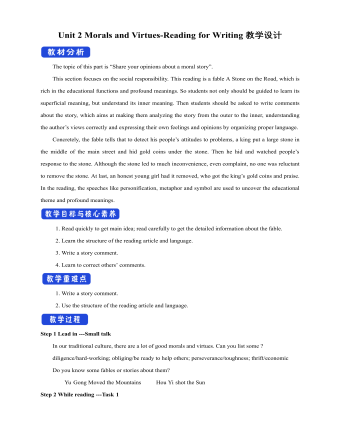
新人教版高中英语必修3Unit 2 Morals and Virtues-Reading for Writing教学设计
1. 这个寓言是一个关于一位国王古寓言。 The fable is an old fable about a king.2.作者用这个故事让读者对于社区的问题负有个人责任的必要印象深刻。The author used the story to impress upon readers with the need to take personal responsibility for problems in the community.3. 这个故事十分成功的实现了它的目的。The story was quite successful in achieving its purpose.Step 7 WritingPlease write a review of the story according the outline above.The fable is an old fable about a king who thought his people are lazy, so he put a large stone in the middle of the road and hides and waited to see if anyone will try to move it.The author used this story to impress upon readers with the need to take personal responsibility for problems in the community. The story was quite successful in achieving its purpose, and I liked it because it had a clear moral.However, while the moral of the story is clear, the actions of the king seemed pointless to me, because none of the characters in the story learnt anything. For this reason, I think there are better stories that can be used to impress upon people with the need for personal responsibility.Step 8 Pair workExchange drafts with a partner. Use this checklist to help your partner revise his/her draft.1. Does the writer give a short description of the story ?2. Does the description include the most important details of the story ?3. Does the writer give his or her opinion about the character or their actions ?4. Is the review well-organised ? 5. Does the writer use the -ing form as the adverbial correctly in the writing ?6. Are there any grammar, spelling, or punctuation errors ?Step 9 HomeworkPut up your revised draft in the classroom or read it to your class.






